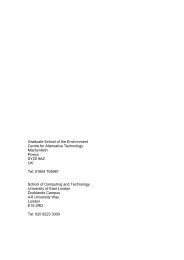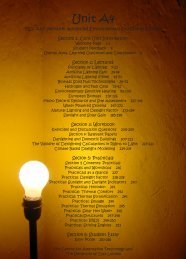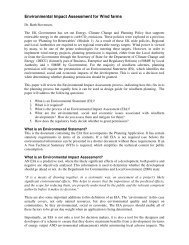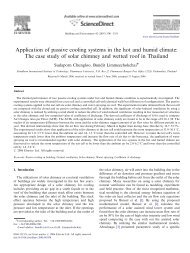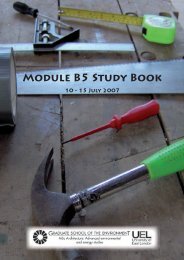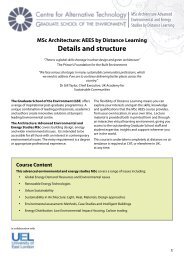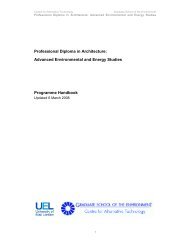Module B1 Study Book - the Graduate School of the Environment
Module B1 Study Book - the Graduate School of the Environment
Module B1 Study Book - the Graduate School of the Environment
Create successful ePaper yourself
Turn your PDF publications into a flip-book with our unique Google optimized e-Paper software.
There is little doubt that initiatives such as pre-assembly and standardisation<br />
are realising improvements within <strong>the</strong> industry which have waste avoidance<br />
spin-<strong>of</strong>fs, but realistically <strong>the</strong> mainstream industry is not addressing <strong>the</strong> issue.<br />
The construction industry as a whole was awakened to <strong>the</strong> immediate costs<br />
<strong>of</strong> waste disposal through <strong>the</strong> introduction <strong>of</strong> <strong>the</strong> landfill tax.<br />
Ironically <strong>the</strong> landfill tax is unlikely to incentivise <strong>the</strong> building services industry<br />
into action because <strong>of</strong> <strong>the</strong> relatively low volume, yet high value wastes<br />
produced.<br />
Dematerialisation, flexibility, pre-assembly and correct specification all<br />
have an important role in streamlining building services to reduce wastes.<br />
Additionally however, <strong>the</strong> more straightforward issues <strong>of</strong> coordination,<br />
communication and buildability are more likely to have an immediate impact<br />
on reducing waste in <strong>the</strong> majority <strong>of</strong> cases.<br />
The wealth <strong>of</strong> solutions to address waste created through design reflects <strong>the</strong><br />
need to understand <strong>the</strong> reasons why wastes are generated in <strong>the</strong> first place.<br />
Each design decision, which is responsible for creating waste needs to be<br />
identified through <strong>the</strong> study <strong>of</strong> wastes arising before realistic designing out<br />
waste solutions are actioned.<br />
REFERENCES<br />
Govt Statistical Service (1998). ‘Digest <strong>of</strong> <strong>Environment</strong>al Statistics’. No/20,<br />
Government Statistical Service<br />
CIRIA (1999). ‘Waste Minimisation and Recycling in Construction’; Boardroom<br />
Handbook. CIRIA<br />
Department <strong>of</strong> <strong>Environment</strong> Transport and <strong>the</strong> Regions (1998). ‘Opportunities<br />
for Change: Consultation<br />
Paper on a UK Strategy for Sustainable Construction’. HMSO<br />
DOE (1995). ‘Making Waste Work – A Waste Strategy for England and Wale’.<br />
DOE HMSO<br />
Department <strong>of</strong> <strong>Environment</strong> Transport and <strong>the</strong> Regions (1999). ‘A Way<br />
with Waste: A Draft Waste Strategy for England and Wales, Parts 1 and 2’.<br />
DETR<br />
Crittenden B, Kolaczkowski S (1995). ‘Waste Minimisation: A Practical Guide’.<br />
IChemE<br />
Trumble W, Frenette M (1998). ‘Nortel’s Green Design Research Project<br />
<strong>Environment</strong>al<br />
Telephone’. Nor<strong>the</strong>rn Telecom Ltd. Ontario, Canada<br />
Deaner M (1991). ‘President American Iron and Steel Institute’. Presentation<br />
<strong>of</strong> <strong>the</strong> Bureau <strong>of</strong> Mines<br />
Forum on Materials Use. Washington DC.<br />
Turner R (1986). ‘Construction Economics and Building Design’. Van<br />
Norstrand Reinhold. New York.<br />
CIRIA (1998). ‘Waste Minimisation and Recycling in Construction’. Design<br />
Manual, SP134-CIRIA,<br />
London<br />
Bunn R, Smith T (1999). ‘Egan – The Way Ahead, M&E Co-ordination’.<br />
Building Services Journal<br />
Bradley P (1999) in Bunn & Smith Article. Egan – The Way Ahead. M&E Co-<br />
138 Paper: Waste Minimisation




